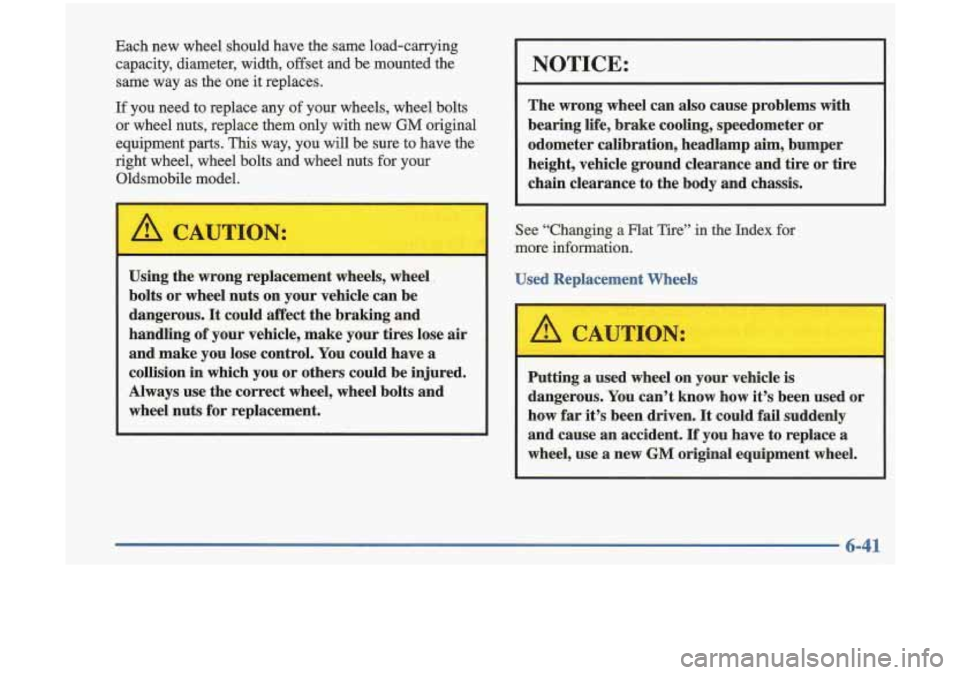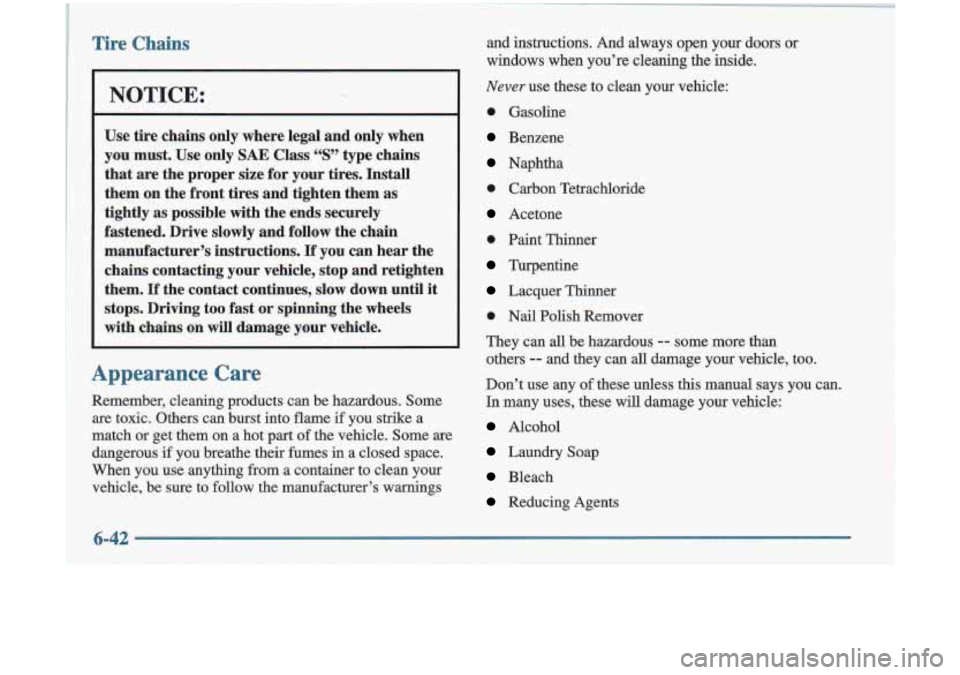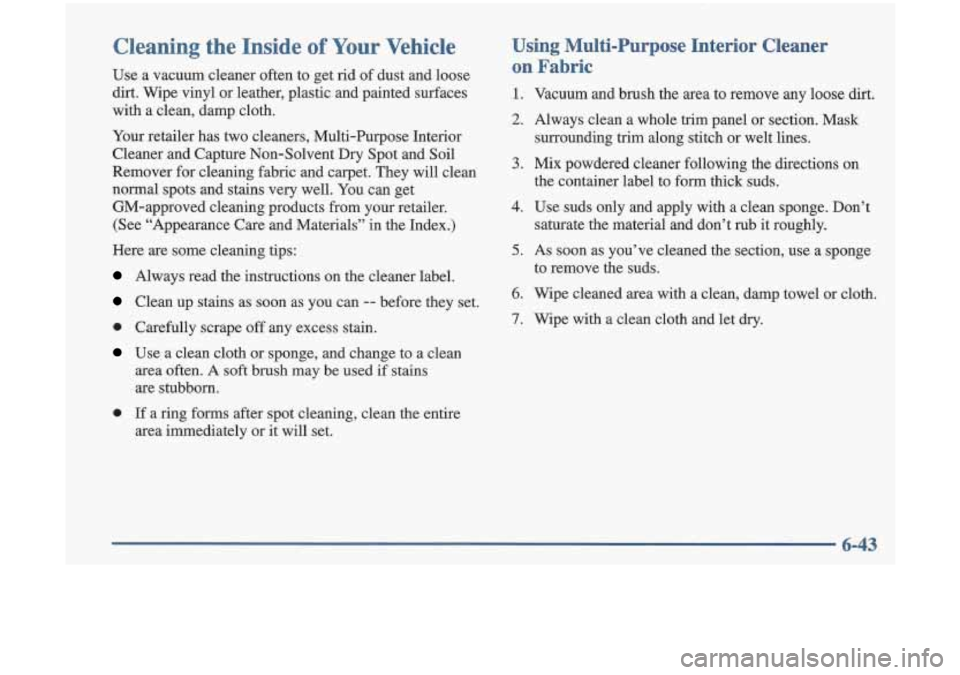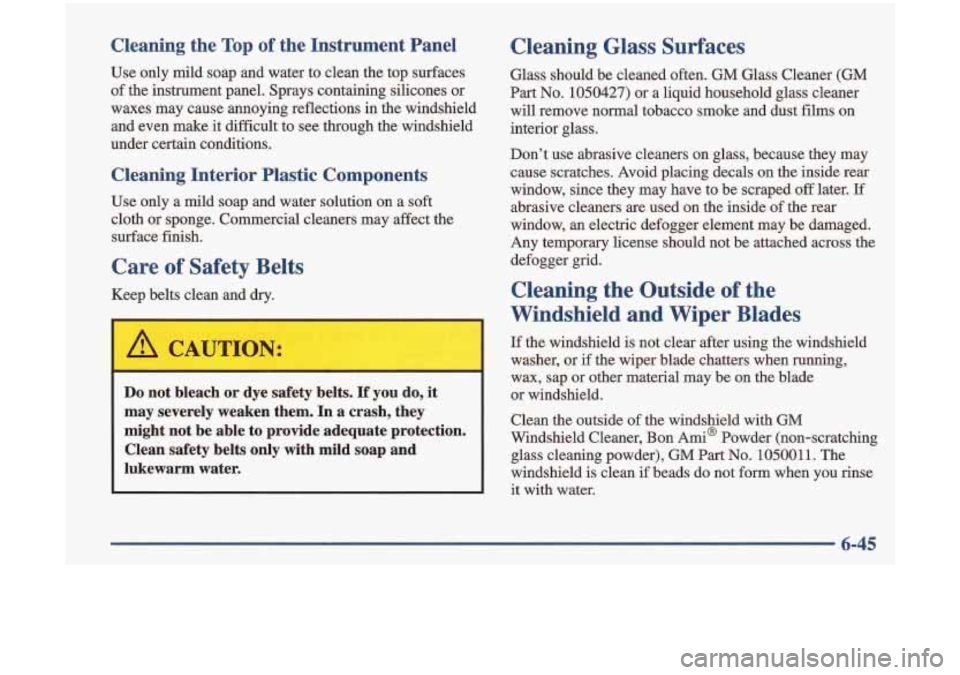Oldsmobile Cutlass 1998 Owner's Manuals
Manufacturer: OLDSMOBILE, Model Year: 1998, Model line: Cutlass, Model: Oldsmobile Cutlass 1998Pages: 348, PDF Size: 17.46 MB
Page 261 of 348

Each new wheel should have the same load-carrying
capacity, diameter, width, offset and be mounted the
same way as the one it replaces.
If you need to replace any of your wheels, wheel bolts
or wheel nuts, replace them only with new GM original
equipment parts.
This way, you will be sure to have the
right wheel, wheel bolts and wheel nuts for your
Oldsmobile model.
I
Using the wrong -)la( nent wheels, wk 1.
bolts or wheel nuts on your vehicle can be
dangerous.
It could affect the braking and
handling of your vehicle, make your tires lose air
and make you lose control. You could have a
collision in which you or others could be injured.
Always use the correct wheel, wheel bolts and
wheel nuts for replacement.
NOTICE:
The wrong wheel can also cause problems with
bearing life, brake cooling, speedometer
or
odometer calibration, headlamp aim, bumper
height, vehicle ground clearance and tire or tire
chain clearance to the body and chassis.
See “Changing a Flat Tire” in the Index for
more information.
Used Replacement Wheels
Putting
a used wheel on your vehicle is
dangerous. You can’t know how it’s been used or
how far it’s been driven. It could
fail suddenly
and cause an accident.
If you have to replace a
wheel, use a new
GM original equipment wheel.
I
6-41
Page 262 of 348

Tire Chains
NOTICE: L
Use tire chains only where legal and only when
you must. Use only
SAE Class “S” type chains
that are the proper size for your tires. Install
them on the front tires and tighten them as
tightly as possible with the ends securely
fastened. Drive slowIy and foIlow the chain
manufacturer’s instructions.
If you can hear the
chains contacting your vehicle, stop and retighten
them,
If the contact continues, slow down until it
stops. Driving too fast
or spinning the wheels
with chains on will damage
your vehicle.
Appearance Care
Remember, cleaning products can be hazardous. Some
are toxic. Others can burst into flame if you strike a
match or get them on a hot
part of the vehicle. Some are
dangerous
if you breathe their fumes in a closed space.
When you use anything from a container to clean your
vehicle, be sure to follow the manufacturer’s warnings and instructions. And always open your doors
or
windows when you’re cleaning the inside.
Never use these to clean your vehicle:
0 Gasoline
Benzene
Naphtha
0 Carbon Tetrachloride
Acetone
e Paint Thinner
Turpentine
Lacquer Thinner
0 Nail Polish Remover
They can all be hazardous
-- some more than
others
-- and they can all damage your vehicle, too.
Don’t use any
of these unless this manual says you can. !
In many uses, these will damage your vehicle:
Alcohol
Laundry Soap
Bleach
Reducing Agents
6-42
Page 263 of 348

Cleaning the Inside of Your Vehicle
Use a vacuum cleaner often to get rid of dust and loose
dirt. Wipe vinyl or leather, plastic and painted surfaces
with a clean, damp cloth.
Your retailer has two cleaners, Multi-Purpose Interior
Cleaner and Capture Non-Solvent Dry Spot and Soil
Remover for cleaning fabric and carpet. They will clean
normal spots and stains very well. You can get
GM-approved cleaning products from your retailer.
(See “Appearance Care and Materials” in the Index.)
Here are some cleaning tips:
Always read the instructions on the cleaner label.
Clean up stains as soon as you can -- before they set.
0 Carefully scrape off any excess stain.
Use a clean cloth or sponge, and change to a clean
area often. A soft
brush may be used if stains
are stubborn.
0 If a ring forms after spot cleaning, clean the entire
area immediately
or it will set.
Using Multi-Purpose Interior Cleaner
on
Fabric
1.
2.
3.
4.
5.
6.
7.
Vacuum and brush the area to remove any loose dirt.
Always clean a whole trim panel or section. Mask
surrounding trim along stitch or welt lines.
Mix powdered cleaner following the directions on
the container label to form thick suds.
Use suds only and apply with a clean sponge. Don’t
saturate the material and don’t rub it roughly.
AS soon as you’ve cleaned the section, use a sponge
to remove the suds.
Wipe cleaned area with a clean, damp towel or cloth.
Wipe with a clean cloth and let
dry.
6-43
Page 264 of 348

Special Fabric Cleaning Problems Cleaning Vinyl
Stains caused by such things as catsup, coffee (black), Use warm water and a clean cloth.
1.
2.
3.
4.
Carefully scrape off excess stain, then sponge the
soiled area with cool water.
If a stain remains, follow the multi-purpose interior
cleaner instructions described earlier.
If an odor lingers after cleaning vomit or urine,
treat the area with a waterhaking soda solution:
1 teaspoon (5 ml) of baking soda to 1 cup (250 ml)
of lukewarm water.
Let -dm.
Things like tar, asphalt and shoe polish will stain if
you don't get them off quickly. Use a clean cloth
and a vinyVleather cleaner. See your retailer for
this product.
Cleaning Leather
Use a soft cloth with lukewarm water and a mild soap or
saddle soap and wipe
dry with a soft cloth. Then, let the
leather dry naturally. Do not use heat to dry.
Stains caused by candy,
ice cream, mayonnaise, chili
sauce and unknown stains can be removed as follows:
1. Carefully scrape off excess stain.
2. First, clean with cool water and allow to
3. If a stain remains, follow instructions for
dry completely.
Multi-Purpose Interior Cleaner.
For stubborn stains, use a leather cleaner. See your
retailer for this product.
0 Never use oils, varnishes, solvent-based or abrasive
0 Soiled or stained leather should be cleaned cleaners,
furniture polish or shoe polish on leather.
immediately. If
dirt is allowed to work into the
finish, it can harm the leather.
6-44
Page 265 of 348

Cleaning the Top of the Instrument Panel
Use only mild soap and water to clean the top surfaces
of the instrument panel. Sprays containing silicones or
waxes may cause annoying reflections in the windshield
and even make it difficult to see through the windshield
under certain conditions.
Cleaning Interior Plastic Components
Use only a mild soap and water solution on a soft
cloth or sponge. Commercial cleaners may affect the
surface finish.
Care of Safety Belts
I /! CAUTION:
Do not bleach or dye safety belts. If you do, it
may severely weaken them. In a crash, they
might not be able to provide adequate protection.
Clean safety belts
only with mild soap and
lukewarm water.
Cleaning Glass Surfaces
Glass should be cleamd often. GM Glass Cleaner (GM
Part
No. 1050427) or a liquid household glass cleaner
will remove normal tobacco smoke and dust films on
interior glass.
Don't use abrasive cleaners on glass, because they may
cause scratches. Avoid placing decals on the inside rear
window, since they may have to be scraped
off later. If
abrasive cleaners are used on the inside of the rear
window, an electric defogger element may be damaged.
Any temporary license should not be attached acro~ss the
defogger grid.
Cleaning the Outside of the
Windshield and Wiper Blades
If the windshield is not clear after using the windshield
washer, or
if the wiper blade chatters when running,
wax, sap or other material may be on the blade
or windshield.
Clean the outside of the windshield with GM
Windshield Cleaner, Bon
Ami@ Powder (non-scratching
glass cleaning powder),
GM Part No. 1050011. The
windshield is clean
if beads do not form when you rinse
it with water.
Page 266 of 348

Page 267 of 348

Finish Care
Occasional waxing or mild polishing of your vehicle by
hand may be necessary to remove residue from the paint
finish.
You can get GM-approved cleaning products
from your retailer. (See “Appearance Care and
Materials” in the
Index.)
Your vehicle has a “basecoatlclearcoat” paint finish. The
clearcaat gives more depth and gloss to the colored
basecoat. Always use waxes and polishes that are
non-abrasive and made for a basecoathlearcoat
paint finish. Foreign materials such as calcium chloride and other
salts, ice melting agents, road oil and tar, tree sap,
bird
droppings, chemicals from industrial chimneys, etc., can
damage your vehicle’s finish if they remain on painted surfaces. Wash the vehicle
as soon as possible. If
necessary, use non-abrasive cleaners that are marked
safe for painted surfaces to remove foreign matter.
Exterior painted surfaces are subject to aging, weather and chemical fallout that can take their toll over a period
of years. You can help to keep the paint finish looking
new by keeping your vehicle garaged or covered
whenever possible.
NOTICE:
Machine compounding or aggressive polishing on
a basecoat/cIearcoat paint
finish may dull the
finish or leave swirl marks.
6-47
Page 268 of 348

Cleaning Aluminum Wheels
(If Equipped)
Keep your wheels clean using a soft clean cloth with
mild soap
and water. Rinse with clean water. after^
rinsing thoroughly, dry with a soft clean towel. A wax
may then be applied.
The surface of these wheels is similar to the painted
surface
of your vehicle. Don’t use strong soaps,
chemicals, abrasive polishes, abrasive cleaners
or
abrasive cleaning brushes on them because you could
damage the surface.
Don’t take your vehicle through an automatic car wash
that has silicon carbide tire cleaning brushes. These
brushes can also damage the surface
of these wheels.
Cleaning Tires
To clean your tires, use a stiff brush with a tire cleaner.
NOTICE:
When applying a tire dressing always take care to
wipe
off any overspray or splash from all painted
surfaces
on the body or wheels of the vehicle.
Petroleum-based products may damage the paint
finish.
Sheet Metal Damage
If your vehicle is darnaged and requires sheet metal
repair or replacement, make sure the body repair shop
applies anti-corrosion material to the parts repaired
or
replaced to restore corrosion protection.
6-48
Page 269 of 348

Finish Damage
Any stone chips, fractures or deep scratches in the finish
should be repaired right away. Bare metal will corrode
quickly and may develop into
a major repair expense.
Minor chips and scratches can be repaired with touch-up
materials available from your retailer or other service
outlets. Larger areas of finish damage can be corrected
in your retailer’s body and paint shop.
Underbody Maintenance Chemical Paint Spotting
Some weather and atmospheric conditions can create
a
chemical fallout. Airborne pollutants can
fall upon and
attack painted surfaces
on your vehicle. This damage
can take two forms: blotchy, ringlet-shaped
discolorations, and small irregular dark spots etched into
the paint surface.
Although no defect
in the paint job causes this,
Oldsmobile will repair, at no charge to the owner, the
surfaces of new vehicles damaged by this fallout
condition within
12 months or 12,000 miles (20 000 lun)
of purchase, whichever occurs first.
6-49
Page 270 of 348

Appearance Care Materials Chart
PART NUMBER SIZE DESCRIPTION USAGE
994954 23 in. x 25 in. Polishing Cloth - Wax Treated Exterior polishing cloth
1050172
16 oz. (0.473 L) Tar and Road Oil Remover Removes tat, road oil and asphalt
1050173
16 oz. (0.473 L) Chrome Cleaner and Polish Use on chrome, stainless steel, nickel, copper and brass
1050174 16
oz. (0.473 L) White Sidewall Tire Cleaner Removes soil and black marks from \
whitewalls
1050214 32
oz. (0.946 L)
Vinyl Cleaner
1050427 23
oz. (0.680 L)
Glass Cleaner
I 1052870 I 16 oz. (0.473 L) I Wash Wax Concentrate
I 1052918"" I 8 oz. (0.237 L) I Armor All" Protectant
1052925 16
oz. (0.473 L) Multi-Purpose Interior
Cleaner
1052929 16
oz. (0.473 L) Wheel Cleaner
1052930
8 oz. (0.237 L) Capture Dry Spot Remover
12345002 16
oz. (0.473 L)
Armor All" Cleaner
12345721 2.5
sq. ft. Synthetic Chamois
12345725 12
oz. (0.354 L)
Silicone Tire Shine
12377964 16
oz. (0.473 L)
Finish Enhancer
12377966 16
oz. (0.473 L) Cleaner Wax
12377984 16 oz. (0.473 L) Surface Cleaner
See your General Motors Parts Department for these products.
I See "Fluids and Lubricants" in the Index. Cleans vinyl tops, upholstery and convertible tops
Removes
dirt, grime, smoke and fingerprints
I Cleans and lightly waxes
~ ~~
Protects leather, wood, acrylics, Plexiglas " , plastic, -
rubber and vinyl I
Cleans carpets, seats, interior trim, door panels
and floor mats
I
Spray on and rinse with water
Attracts, absorbs and removes
soils
Cleans and shines a variety of surface types
Shines vehicle without scratching Spray on tire shine
Removes dust, fingerprints and surface contaminants
Removes light scratches and oxidation and protects &ish
Removes contaminants, blemishes and swirl marks
'* Not recommended for use on instrument panel vinyl.
6-50